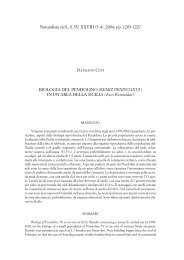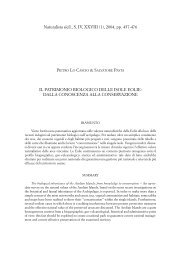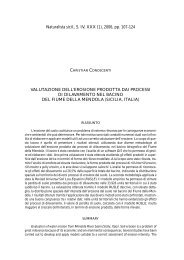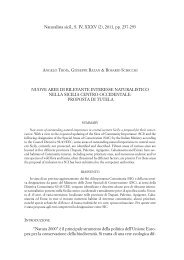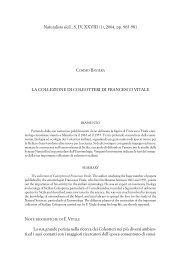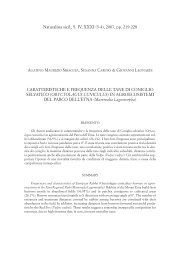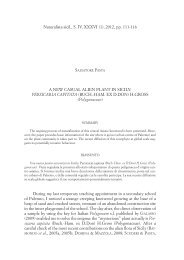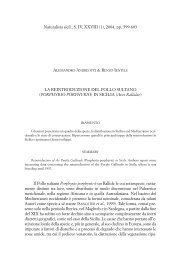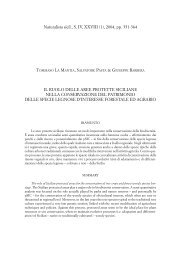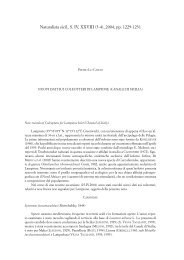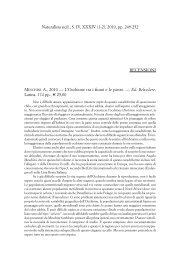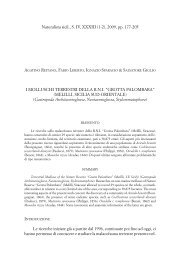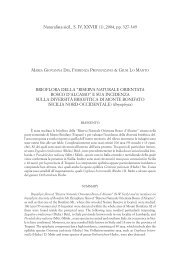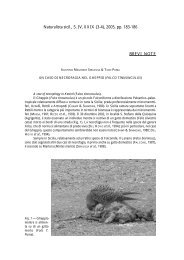2007,pp - Società Siciliana di Scienze Naturali
2007,pp - Società Siciliana di Scienze Naturali
2007,pp - Società Siciliana di Scienze Naturali
Create successful ePaper yourself
Turn your PDF publications into a flip-book with our unique Google optimized e-Paper software.
Gall midges (Diptera Cecidomyiidae) of Sicily<br />
263<br />
Among the great scientific activity carried out by Francesco MINÀ<br />
PALUMBO (1814-1899) there was an interesting list of insects noxious to wheat,<br />
that he published on 1882 on the “Il <strong>Naturali</strong>sta Siciliano”, the predecessor of<br />
our present journal; this list includes two gall midge species, not recorded in<br />
Sicily by other authors.<br />
In the meantime, Adolfo TARGIONI-TOZZETTI (1823-1902), professor of<br />
Zoology and comparative Anatomy of vertebrates at the Istituto <strong>di</strong> Stu<strong>di</strong><br />
superiori of Firenze and founder of the Stazione <strong>di</strong> Entomologia Agraria of<br />
Firenze, described two gall midge species found in Sicily; his contribution to<br />
cecidology was much a<strong>pp</strong>reciated by TROTTER (1902). Afterwards KIEFFER &<br />
CECCONI (1906), KIEFFER (1909), FELT (1914) and BARNES (1932) described<br />
other gall midge species on the basis of the material collected in Sicily, and<br />
TROTTER & CECCONI (1900-1917) listed the occurrence of several Sicilian gall<br />
midge species in their important publication “Cecidotheca Italica”.<br />
The homonym grandson of T. De Stefani (1909-1978) inherited the collection<br />
of his grandfather and de<strong>di</strong>cated himself to scientific stu<strong>di</strong>es, inclu<strong>di</strong>ng<br />
entomology. In 1942 he published a list of Sicilian gall inducing arthropods,<br />
really not ad<strong>di</strong>ng any previously unknown species (DE STEFANI-AGRIGENTO,<br />
1942) 1 . The collection of T. De Stefani Perez, inclu<strong>di</strong>ng many types of species<br />
described by him, has to be considered lost (V. Caleca, pers. comm.) and it is<br />
urgently needed to establish neotypes.<br />
In the last thirty years of the 20 th century some gall midge species once<br />
more drew the attention of researchers in agriculture. RAGUSA (1970a,<br />
1970b), GENDUSO & RAGUSA (1970) and LIOTTA (1981) carrying out<br />
researches on pests of olive mentioned the occurrence of Lasioptera<br />
berlesiana, while RAGUSA (1970c) stu<strong>di</strong>ed the biology of Dasineura affinis.<br />
VACANTE (1985), VACANTE & FIRULLO (1983) and COLOMBO et al. (1993)<br />
stu<strong>di</strong>ed the use of the predacious gall midge species Feltiella acarisuga<br />
(=Thero<strong>di</strong>plosis persicae) as biological control of tetranychid mites in greenhouses.<br />
RIZZO & MASSA (1998) reported on two gall midge species from Sicily,<br />
one of them previously unrecorded; SISCARO et al. (1999) stu<strong>di</strong>ed natural<br />
enemies of Aoni<strong>di</strong>ella aurantii and reported the presence of Lesto<strong>di</strong>plosis<br />
aoni<strong>di</strong>ellae in Sicily. MINEO et al. (1997) recorded an unidentified cecidomyiid<br />
as a parasitoid of Aphis parietariae, while BLANDO & MINEO (2006) mentioned<br />
the occurrence of Lasioptera berlesiana. PERI et al. (2006) wrote on the<br />
key pest of the caper (Ca<strong>pp</strong>aris spinosa) and SUMA et al. (<strong>2007</strong>) on Hori<strong>di</strong>plosis<br />
ficifolii damaging Ficus trees in Sicilan nurseries.<br />
1 Agrigento was the mother name of T. De Stefani; hereafter, we report his reference as DE<br />
STEFANI jr (1942).



